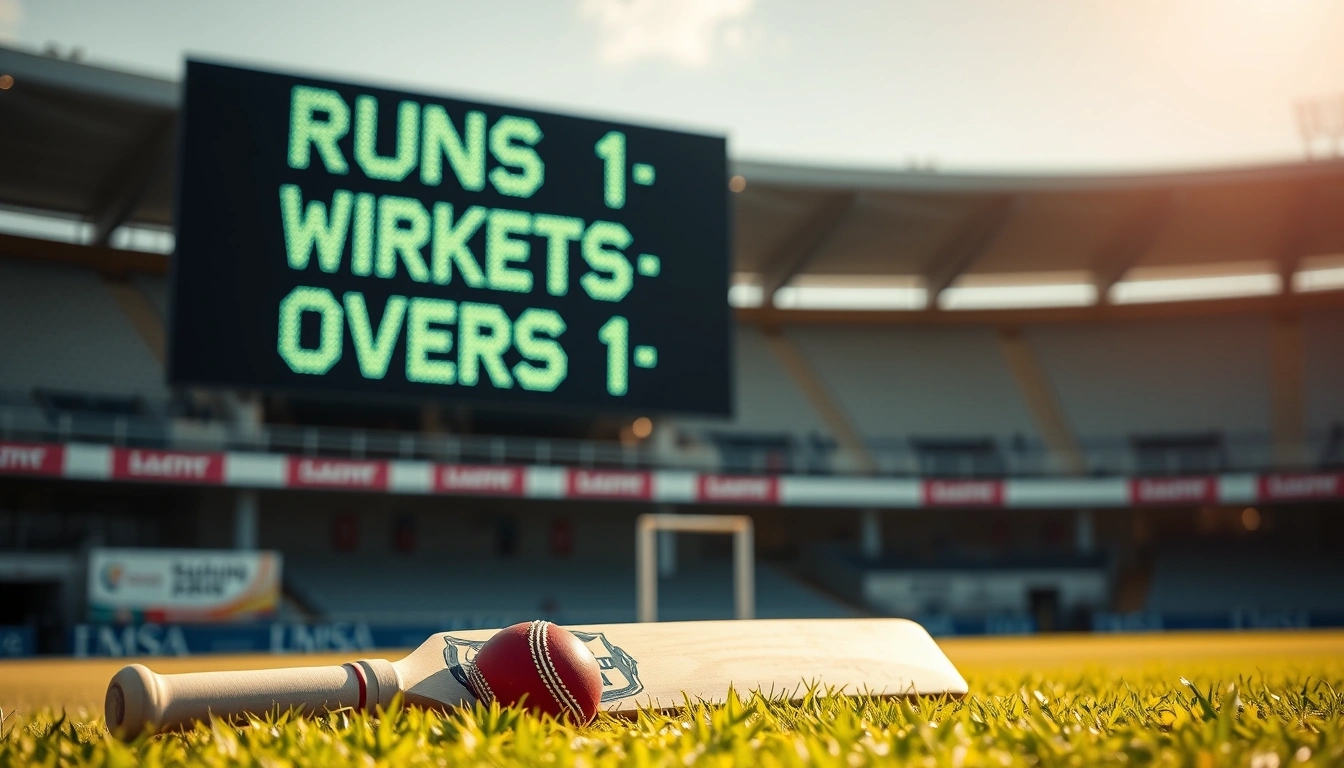Cricket scoring might look like a wild jungle at first glance—numbers, dots, wickets, extras flying everywhere—but trust me, it’s not as cryptic as it seems. If you’re new to the game, this guide will walk you through the essentials of how runs, wickets, and extras come together to paint the scoreboard’s ever-changing picture. Think of it as your personal map through the maze of cricket numbers, helping you catch the drama as it unfolds on the pitch.
What is cricket scoring all about?
At its core, cricket scoring is the story of a match told in numbers. Runs show how many points the batting team has earned, wickets reveal how many players have been dismissed, and overs tell you how many sets of six balls have been bowled. Together, they sketch the progress and tension of the game. Imagine a scoreboard as a scoreboard as a pulse, beating with every run and wicket, keeping fans on the edge of their seats.
- Runs: The currency of cricket, scored by batsmen hitting the ball and running between the wickets or hitting boundaries.
- Wickets: The number of batsmen who’ve been dismissed; lose too many, and the innings ends.
- Overs: Sets of six balls bowled; they dictate the pace and strategy of the match.
Runs: The heart of cricket scoring
Runs are what everyone’s after. Whether it’s a sneaky single run, a cheeky two, or the crowd-pleasing boundary (four runs) and six (hello, big hit!), every run adds up. It’s not just about smashing the ball; smart running between wickets can be just as valuable. And don’t underestimate the pressure of chasing a target where every single run counts. It’s like a slow-burning thriller where the scoreboard ticks up, inch by inch.
| Type of Run | How It’s Scored | Points Awarded |
|---|---|---|
| Single | Batsmen run to the other crease once | 1 |
| Boundary | Ball reaches the edge of the field after bouncing | 4 |
| Six | Ball clears the boundary without bouncing | 6 |
Wickets and their impact on the score
Losing wickets is like losing soldiers in a battle—each one weakens the batting side’s chances. When a batsman is out, it’s called a wicket, and the team’s innings edges closer to an end. The fewer wickets lost, the better the team’s position. But cricket loves to throw curveballs—sometimes a team with many wickets down can still pull off a miracle.
Overs: The ticking clock of cricket
An over consists of six legal deliveries bowled by a single bowler. Overs set the rhythm; in limited-overs formats like ODIs or T20s, the number of overs is capped, adding urgency. In Test cricket, it’s more about endurance, but overs still matter for strategy. Think of overs as innings’ heartbeat—steady, relentless, and full of tension.
Extras: The sneaky contributors to the score
Extras are those cheeky runs that don’t come off the bat but still add to the total—wides, no-balls, byes, and leg byes. They can be a thorn in the bowler’s side and sometimes swing momentum. Imagine a bowler bowling a wide ball: the batting team gets an extra run, and the bowler has to bowl an extra delivery. Annoying, right? But that’s cricket for you.
- Wides: Ball bowled out of batsman’s reach, 1 extra run + extra ball
- No-balls: Illegal deliveries, 1 extra run + free hit
- Byes: Runs made when ball passes batsman without contact
- Leg byes: Runs made when ball hits batsman’s body, not bat
Reading the scoreboard: What all those numbers mean
If you see something like 150/3 (20 overs), it means the batting team has scored 150 runs, lost 3 wickets, and 20 overs have been bowled. Simple, right? But the context—like required runs, wickets left, overs remaining—adds layers of excitement. It’s like reading a novel where every number hints at what’s coming next.
Formats and how scoring differs
Cricket isn’t one-size-fits-all. Test matches span five days with unlimited overs, so scoring is slow and strategic. ODIs have 50 overs per side, and T20s just 20 overs—fast, furious, and packed with big hits. Scoring tactics shift accordingly, with more risk-taking in shorter formats.
Common scoring terms every newbie should know
- Duck: Getting out without scoring a run
- Maiden over: An over with zero runs conceded
- Run out: Batsman dismissed while trying to run
- Strike rate: Runs scored per 100 balls faced
How to keep score yourself: Basics for beginners
Want to try scoring? You’ll need a simple scorebook or app. Track runs, wickets, overs, and extras. It’s like being a detective, piecing together the game’s story ball by ball.
Scoring controversies and quirks
Cricket scoring isn’t always neat. Remember that time when a ball bounced off a fielder’s helmet and went for six? Or when a run-out decision sparked heated debates? These moments show scoring can be unpredictable.
Using technology in cricket scoring
Thanks to tech like DRS and Hawk-Eye, scoring is more accurate than ever. Digital scoreboards and apps keep fans glued, making sure no run or wicket goes unnoticed.
Why understanding scoring makes watching cricket more fun
Knowing the score’s ins and outs turns watching cricket from a passive experience into an edge-of-the-seat thrill ride. Every run feels earned, every wicket a mini-drama. So dive in, and let the numbers tell you the story.
What is cricket scoring all about?
Cricket scoring might look like a bunch of numbers tossed around with no rhyme or reason, but trust me, it’s the heartbeat of every match. When you watch a game, those runs, wickets, and overs aren’t just stats—they’re the story unfolding ball by ball. So, what’s the deal with all this scoring jazz? Let’s break it down in a way that even your mate who’s never seen a cricket ball can get it.
First off, runs are the currency of cricket. Every time the batsmen manage to sprint between the wickets or hit the ball to the boundary, they’re stacking up runs. These runs pile up to decide who’s winning, losing, or just hanging in there for dear life. But runs alone don’t tell the whole tale.
Then come the wickets. These are like the game’s plot twists. When a batsman gets out, it’s a wicket lost. Lose too many, and the batting team is in trouble, scrambling to add whatever runs they can before they’re all out. It’s a bit like losing players in a video game—you want to keep as many on the field as possible.
And finally, the overs. Think of overs as the ticking clock of cricket. An over is a set of six legal deliveries bowled by one bowler. The number of overs bowled tells you how far along the match is, and it also shapes the strategies teams use. In shorter games, every over is a sprint; in longer formats, it’s more like a marathon.
| Element | What It Means | Why It Matters |
|---|---|---|
| Runs | Points scored by the batting side | Determines the team’s total score and potential to win |
| Wickets | Number of batsmen dismissed | Limits the batting side’s ability to score runs |
| Overs | Sets of six balls bowled | Controls the pace and length of the game |
Now, if you’re scratching your head thinking, “Okay, but how do these bits fit together?” imagine a cricket match as a storybook. The runs are the chapters, the wickets are the cliffhangers, and the overs are the pages turning. Every ball bowled adds a new sentence to the story. Sometimes it’s thrilling—like a quick boundary or a wicket falling at a crucial moment—and sometimes it’s just a slow build-up, tension mounting like waiting for your favorite band to finally hit the stage.
- Runs keep the scoreboard ticking.
- Wickets can change the game’s momentum instantly.
- Overs dictate how much time teams have to chase or defend a target.
But hey, cricket isn’t just about numbers—it’s about the drama behind those numbers. A team could be cruising with loads of runs but suddenly lose wickets like dominoes, and that scoreboard story flips on its head. Or the overs might be running out, forcing batsmen to take risks they wouldn’t normally take. It’s this blend of strategy, skill, and a bit of luck that makes cricket scoring far more than just tallying runs.
So next time you glance at the scoreboard and see something like “150-3 in 20 overs,” you’ll know exactly what’s going on: the batting team has scored 150 runs, lost 3 wickets, and used 20 overs. That’s the snapshot of the game’s pulse at that moment. And honestly, once you get this, watching cricket becomes a whole lot more exciting—because you’re not just watching players hit balls, you’re reading a story that’s constantly evolving.
In short: Cricket scoring is the language of the game. Runs are the points, wickets are the setbacks, and overs are the clock. Put them together, and you get a fascinating, unpredictable narrative that keeps fans on the edge of their seats.
Runs: The heart of cricket scoring
Cricket, at its core, is a game of runs. You might hear commentators throw around terms like “singles,” “boundaries,” or “sixes,” and if you’re new to the game, it can all sound like some secret code. But don’t sweat it — runs are just the currency of cricket, the way teams measure their success on the field. Every run matters, whether it’s a quick single or a thunderous six that sends the ball soaring out of the park.
So, how exactly do these runs come about? Let’s break it down. The simplest way to score is by running between the wickets. When the batsman hits the ball and both batsmen sprint from one end of the pitch to the other, each completed run adds to the team’s total. These are called singles (one run), but if they manage to run twice or thrice before the fielders can return the ball, that’s two or three runs, respectively. Sounds straightforward, right? But here’s the catch — running between wickets requires quick thinking and speed, and sometimes the risk isn’t worth the reward.
| Type of Run | How It Happens | Why It Matters |
|---|---|---|
| Single | Running once between wickets | Builds the team’s score steadily |
| Boundary (Four) | Ball crosses the boundary after touching the ground | Instant 4 runs, quick boost |
| Six | Ball clears the boundary without touching the ground | Maximum 6 runs, game-changer |
Now, onto the crowd-pleasers: boundaries and sixes. When the ball races to or over the edge of the field, it’s an automatic 4 or 6 runs — no running required. Boundaries are like the espresso shots of cricket scoring: quick, energizing, and they get the crowd roaring. Sixes? They’re the fireworks. When a batsman smashes the ball high and far enough to clear the boundary without the ball touching the ground, it’s a six — the maximum runs from a single hit. It’s risky, sure, but when it pays off, it can shift momentum in a heartbeat.
- Why every run counts: Cricket matches can be nail-biters where the difference between winning and losing boils down to just a handful of runs. Even the tiniest run can be crucial in tight games.
- Building partnerships: Runs aren’t just individual achievements. Partnerships between batsmen, accumulating runs together, put pressure on the bowling side and set a platform for big totals.
- Strategic running: Smart batsmen judge when to take singles and when to hold back, balancing aggression with caution.
Here’s a quick cheat sheet for you to keep in mind:
- Singles: The bread and butter of scoring. Keep the scoreboard ticking.- Boundaries (4s): Let the ball do the running, but timing is key.- Sixes: Risky but rewarding, they electrify the game.- Every run adds up: No matter how small, runs build pressure on the opposition.
In the grand scheme, runs are the heartbeat of cricket. They tell the story of the match, the ups and downs, the moments of brilliance, and the nerve-wracking tension. So next time you watch a game, keep an eye on how those runs come in — it’s not just numbers on a board, it’s the pulse of cricket itself.

Wickets and their impact on the score
Alright, let’s dive into the world of wickets — those little moments that can flip a cricket match on its head faster than you can say “Howzat!” If you’re new to cricket, wickets might sound like just a part of the game, but trust me, they’re much more than just a number on the scoreboard. They’re like the heartbeat of the game, dictating how the batting team plays and how the game unfolds.
What exactly is a wicket? At its core, a wicket in cricket means a batsman is out. When a player loses their wicket, they have to leave the field, and the next batsman steps in. Sounds simple, right? But the consequences? Oh, they can be massive. Losing wickets means the batting side has fewer players left to score runs, and that can put serious pressure on the team.
- Early wickets: Imagine your top batsmen walking back to the pavilion early — it’s like losing your star players in a football match. The middle and lower order have to step up, often under pressure, which can lead to a collapse.
- Middle overs: This is the tricky phase. Losing wickets here can slow down scoring because teams become cautious, trying to rebuild the innings.
- Death overs: If wickets tumble here, it can kill any late surge the batting side was planning.
| Wicket Situation | Impact on Batting Side | Typical Team Response |
|---|---|---|
| Early Wickets (1-3) | High pressure, reduced scoring power | Consolidate, defensive play |
| Middle Wickets (4-7) | Innings stabilization or collapse | Build partnerships, cautious batting |
| Late Wickets (8-10) | Limited scoring options | All-out attack or survival mode |
Now, here’s the kicker: wickets don’t just affect the batting team’s mindset; they can completely shift momentum. Think of it this way — if a bowler snags a wicket, the fielding side gets a massive morale boost, and suddenly, the crowd’s roaring, the pressure piles up on the batting side, and mistakes start piling up. It’s like a domino effect.
But losing wickets isn’t always doom and gloom. Sometimes, a team losing a few wickets quickly can wake them up, making the batsmen more aggressive or forcing the captain to shuffle strategies. Cricket’s a funny game like that — unpredictable as heck.
Practical tip for newbies:- Watch how teams react after losing a wicket.- Notice if the scoring slows down or speeds up.- See how partnerships form to steady the ship.
To sum it up, wickets are the game-changers in cricket. They’re the moments that can make you jump out of your seat or bite your nails. Every wicket lost tightens the screws on the batting side and opens up new opportunities for the bowlers and fielders. So next time you watch a match, keep an eye on those wickets — because they tell you a lot about how the game is really going down.
And hey, if you ever think cricket’s just about runs, remember — sometimes, it’s the wickets that tell the real story.
Overs: The ticking clock of cricket
Alright, let’s get into the nitty-gritty of overs, one of the most fundamental yet sometimes confusing parts of cricket. If you’re new to the game, you might wonder, “What the heck is an over anyway?” Well, an over is basically a set of six legal deliveries bowled by one bowler from one end of the pitch. Six balls, no more, no less. Simple, right? But don’t let that simplicity fool you—overs are the heartbeat of the game’s rhythm and strategy.
- Six balls per over: Each over consists of six balls that count legally. If the bowler bowls a wide or a no-ball, those deliveries don’t count towards the six and must be re-bowled.
- Change of ends: After an over is completed, the bowling switches ends, so the next bowler bowls from the opposite side of the pitch.
- Bowler rotation: The same bowler can’t bowl two consecutive overs, so the captain has to juggle the bowling attack smartly.
Now, why do overs matter so much? Think of overs as the ticking clock in a game of chess. They set the pace and force teams to balance aggression with caution. In limited-overs cricket, like One Day Internationals (ODIs) or T20s, the number of overs is capped—50 or 20 per innings respectively—which means batsmen have to score runs quickly but without losing wickets recklessly. In Test cricket, overs aren’t limited per innings, but the game is timed over five days, so overs still keep the game moving.
| Format | Overs per innings | Impact on strategy |
|---|---|---|
| Test | Unlimited (time-based) | Patience and endurance; batsmen can take their time |
| ODI | 50 | Balanced aggression; pacing the innings is key |
| T20 | 20 | Fast-paced; every ball counts, high risk and reward |
Overs also influence the bowling tactics. For instance, in the first few overs—called the “powerplay” in limited-overs games—only a few fielders are allowed outside the inner circle, encouraging batsmen to attack early. Captains decide which bowler to unleash when, trying to get early wickets or stem the flow of runs. The timing and number of overs bowled by each player can make or break a team’s chances.
Why overs matter:- Set the rhythm of the game- Dictate batting and bowling strategies- Impact pressure on players (both batsmen and bowlers)- Define the length and structure of the match
So, next time you watch cricket, keep an eye on the overs. They’re not just a boring count of balls; they’re the invisible clock that controls everything—from how quickly runs pile up to when bowlers make their move. Without overs, cricket would be like a movie without a script—chaotic and confusing. And trust me, no one wants that.
In short, overs are the silent puppeteers pulling the strings behind every thrilling chase, nail-biting defense, and game-changing moment on the field. Understanding overs is like having the secret decoder ring for cricket’s pacing and strategy. So, don’t just watch the runs or wickets—watch the overs tick by, and you’ll start to see the game in a whole new light.
Extras: The sneaky contributors to the score
Cricket isn’t just about the batsmen smashing boundaries or bowlers taking wickets; there’s a whole sneaky world of extras lurking in the background, quietly padding the scoreboard. These extras—wides, no-balls, byes, and leg byes—may seem like minor details, but they can seriously mess with the flow of the game and sometimes change its outcome. Let’s unravel these cheeky runs and see why they deserve more attention than they usually get.
Wides and No-balls: The bowler’s blunders that gift runs
Imagine the bowler’s trying to be all precise and suddenly, oops! The ball sails way off the mark—too wide for the batsman to reach. That’s a wide, and it instantly adds one run to the batting team’s tally. Worse yet, the ball has to be re-bowled, which means more pressure and more chances to score. Then there’s the no-ball, which is like a double whammy. It’s an illegal delivery—maybe the bowler’s foot creeped over the crease or the ball bounced too high—and the batting side gets a free run plus a free hit on the next ball. Free hits? Yeah, that’s like a golden ticket for the batsman to swing without fear of getting out in most ways. Sneaky, huh?
| Type of Extra | What It Means | Runs Awarded | Effect on Game |
|---|---|---|---|
| Wide | Ball too wide for batsman to hit | 1 run + extra ball | Increases runs, adds pressure to bowler |
| No-ball | Illegal delivery (foot fault, high full toss) | 1 run + free hit | Extra run, free hit benefits batsman |
| Bye | Batsman misses ball, but runs taken | Runs scored by running | Runs added, no batsman credit |
| Leg bye | Ball hits batsman’s body, not bat, runs taken | Runs scored by running | Runs added, no batsman credit |
Byes and Leg Byes: When the ball escapes the batsman’s control
Now, the other two extras—byes and leg byes—are the sneaky runners on the pitch. When the batsman misses the ball but the ball races away, the pair can scamper between the wickets and grab runs not credited to the batsman. Byes happen when the ball doesn’t touch the bat or the batsman’s body, while leg byes occur when the ball hits the batsman’s pads or body but not the bat. These runs can frustrate bowlers and fielders alike because they feel like “freebies” that sneak past their defense.
- Byes: Runs taken after the ball passes the wicketkeeper without contact with bat or body.
- Leg Byes: Runs taken when the ball hits the batsman’s body (but not the bat) and they run.
Why do extras matter? More than you think!
Extras might seem like “just a few runs,” but in tight matches, they’re often the difference between a nail-biting finish and a comfortable win. A team that concedes too many wides or no-balls is basically gifting the opposition extra chances to pile on runs. Plus, extras can frustrate bowlers and disrupt their rhythm—imagine trying to keep your cool when you keep slipping up with no-balls or wides. On the flip side, batsmen love extras because they add to the scoreboard without lifting a bat, which can be a sneaky morale booster.
Pro Tip for Newbies:Keep an eye on extras when watching a game. If one side is leaking a ton of wides or no-balls, it’s a sign of sloppy bowling or pressure mounting. Sometimes, these extras tell a story that the main runs and wickets don’t show.
In short, extras are the unseen characters in cricket’s drama, quietly tipping the scales. So next time you watch a match, don’t just cheer for the sixes and wickets—give a nod to those sneaky extras that keep the scoreboard ticking in unexpected ways.

Reading the scoreboard: What all those numbers mean
Alright, so you’re staring at the cricket scoreboard, and it might as well be written in ancient hieroglyphics. Runs, wickets, overs, and a bunch of other numbers flashing like a stock market ticker. Don’t panic! This little guide will help you crack the code so you can follow the match without feeling totally lost.
First things first: the runs. This is the most straightforward bit — runs are basically the points the batting team racks up. You’ll see a big number, say 150, which means the team has scored 150 runs so far. Simple, right? But wait, there’s more. Next to the runs, there’s usually a slash and another number, like 150/3. That second number? That’s the wickets lost. So, the batting side has lost three players out of their ten wickets. If you see 150/3, it means 150 runs scored and 3 wickets down.
| Scoreboard Element | What It Means |
|---|---|
| Runs (e.g., 150) | Total runs scored by batting team |
| Wickets (e.g., 150/3) | Number of batsmen dismissed |
| Overs (e.g., 20.4) | Number of completed overs and balls bowled in current over |
Now, about overs. An over is a set of six legal deliveries bowled by one bowler. So when you see something like 20.4, it means 20 complete overs have been bowled, plus 4 balls into the 21st over. Confusing? Well, it’s like counting innings in baseball but with a twist — the decimal isn’t a fraction, it’s balls bowled in the current over. Keep this in mind because overs help you gauge how much time the batting team has left to score.
- Why overs matter: In limited-overs cricket (like T20 or ODI), there’s a fixed number of overs per innings, so every ball counts.
- In Test cricket: overs keep going until the innings is over, so the scoreboard might look different.
Extras also sneak onto the scoreboard, often overlooked but important. These are runs given to the batting team that aren’t credited to any batsman — things like wides, no-balls, byes, and leg byes. They’ll usually be shown separately as Extras: 5 or something similar. Don’t ignore them; those sneaky extras can tip the balance in a tight game.
Example scoreboard snippet:Team A: 150/3 (20.4 overs)Extras: 5
So, putting it all together, the scoreboard tells you the story of the game in numbers: how many runs scored, how many wickets lost, how far through the innings we are, and even those pesky extras. Next time you catch a game, glance at the scoreboard and try to piece together what’s happening. It’s like reading a thriller novel — every number counts, and the plot twists with every ball bowled.
In short, don’t let the scoreboard intimidate you. It’s just a snapshot of the battle between bat and ball, and once you get the hang of it, you’ll be shouting “Howzat!” and “Boundary!” like a pro in no time.
Formats and how scoring differs
Cricket, as you might’ve noticed, isn’t just one game but a whole family of formats, each with its own vibe and, more importantly, its own quirks when it comes to scoring. If you’re just stepping into the cricket world, brace yourself — the way runs pile up and wickets tumble can feel like a totally different beast depending on whether you’re watching a Test, ODI, or T20 match. So, let’s unravel this mess and see what beginners should keep an eye on in each format.
| Format | Duration | Scoring Focus | What Beginners Should Watch Out For |
|---|---|---|---|
| Test Cricket | Up to 5 days, unlimited overs | Patience, building innings, big scores over time | Runs accumulate slowly; wickets can be game-changers; extras less frequent but crucial |
| One Day Internationals (ODI) | 50 overs per side | Balanced aggression; steady run rate; wickets impact momentum | Watch the run rate closely; wickets can slow scoring; extras can sneakily add up |
| T20 | 20 overs per side | Fast-paced, big hitting, quick wickets | Every ball counts; boundaries and sixes dominate; wickets can halt momentum instantly |
First off, Test cricket is like the marathon of the sport. Scoring here is a slow dance — batsmen take their time, and runs trickle in steadily. You won’t see a flurry of sixes every over, but patience is the name of the game. Beginners might find this format a bit snoozy at times, but don’t be fooled! Each run is hard-earned, and losing a wicket can send shockwaves through the entire team. Extras — those sneaky runs from wides or no-balls — don’t usually pile up, but when they do, they can be a subtle edge.
Now, flip the coin to ODIs. Here, the game is a bit like a rollercoaster — fast enough to keep you hooked but with some breathing room. Scoring gets more aggressive, and the run rate becomes a key stat to watch. If the batting side loses wickets early, the scoring rate often dips, making it a bit tense. For newbies, keep an eye on how the team manages the 50 overs — are they accelerating or playing it safe? Also, extras tend to pop up more than in Tests, so don’t ignore them!
- Key takeaway: In ODIs, the balance between scoring quickly and preserving wickets is delicate.
- Run rate is your best friend to gauge how well a team is doing.
And then, there’s the T20 format — cricket’s wild child. Here, every ball is a mini-event. Runs fly off the bat in boundaries and sixes, and wickets can change the game in a blink. It’s fast, furious, and sometimes downright chaotic. If you blink, you might miss a game-changing moment. Beginners should focus on the scoreboard’s run rate and boundary count because these numbers tell you how the game’s swinging. Extras can be costly here too — a single wide or no-ball can be the difference between winning and losing.
T20 Scoring Snapshot:- 20 overs 120 balls max per innings- Average team score: 150-200 runs- Boundaries and sixes dominate scoring- Wickets fall faster but teams often have explosive hitters ready
To wrap it up, the scoring nuances in cricket formats are like different spices in a recipe — each adds its own flavor. Test cricket is about endurance and strategy, ODIs mix patience with bursts of aggression, and T20s are all about speed and spectacle. For beginners, understanding these nuances not only helps in following the game but also in appreciating the subtle shifts that make cricket endlessly fascinating.
So next time you’re glued to a match, remember: the scoreboard isn’t just numbers, it’s a story — and each format tells it in its own unique way. Keep watching, keep learning, and don’t be afraid to ask why that run counts differently here than there. Cricket’s a game of glorious uncertainties, after all!
Common scoring terms every newbie should know
Alright, so you’ve just started watching cricket, and suddenly the commentators start tossing around words like “duck,” “maiden,” and “extras” like it’s some secret code. Don’t worry, you’re not alone—cricket lingo can be as confusing as trying to understand your mate’s cryptic text messages. But here’s the good news: once you get the hang of these scoring terms, you’ll be nodding along like a pro and maybe even impressing your mates at the next game.
Let’s kick off with the basics: runs. You know, the stuff that actually counts. When a batsman hits the ball and runs between the wickets, they score runs. Simple enough, right? But runs come in flavors: singles (one run), doubles (two), and sometimes even boundaries—which are when the ball reaches the edge of the field. A ball that touches the ground before crossing the boundary nets four runs, while a ball that flies over the boundary without touching the ground is a glorious six. Those sixes? Crowd favorites, no doubt.
Now, what about those pesky wickets? No, it’s not just the wooden sticks behind the batsman—they also represent the batsman getting out. Losing wickets is like losing your best players in a football match: it can seriously mess up your team’s chances. When commentators say, “They’re 50 for 3,” it means the team has scored 50 runs but lost 3 wickets. Keep an eye on this because wickets can turn the game on its head.
| Term | Meaning | Why It Matters |
|---|---|---|
| Run | Basic scoring unit when batsmen run between wickets | Every run adds to the team’s total score |
| Boundary (4) | Ball reaches boundary after bouncing | Quick way to add 4 runs |
| Six | Ball flies over boundary without bouncing | Highest scoring shot, 6 runs |
| Wicket | Batsman gets out | Reduces batting side’s chances |
| Maiden Over | An over with zero runs scored | Great for bowlers to build pressure |
| Extras | Runs not scored by batsman (wides, no-balls, byes) | Can add up and affect match outcome |
Now, let’s talk extras—the sneaky little runs that can frustrate bowlers and delight the batting side. Extras include wides (balls bowled out of the batsman’s reach), no-balls (illegal deliveries), byes (runs taken when the ball passes the batsman and wicketkeeper), and leg byes (runs when the ball hits the batsman’s body but not the bat). They don’t count towards a batsman’s personal score but add to the team’s total. So yeah, even mistakes by bowlers can help the batting side.
If you’re scratching your head over “maiden overs,” here’s the scoop: it’s an over (six legal balls) where the batting team doesn’t score a single run. It’s like a bowling masterclass—quiet but deadly. And if you hear about a “duck,” it’s not a bird—it means a batsman got out without scoring any runs. Poor chap!
- Strike Rate: How fast a batsman scores runs (runs per 100 balls). Higher is better.
- Run Rate: Average runs scored per over. Teams keep an eye on this to pace their innings.
- All Out: When all batsmen are dismissed, ending the innings.
So next time you’re watching a match and the commentator says, “He’s on a golden duck,” you’ll know it means the batsman got out on the very first ball faced. And if someone mentions a “hat-trick,” it’s when a bowler takes three wickets in three consecutive deliveries—a rare and exciting feat.
Bottom line? Cricket scoring terms might seem like a foreign language at first, but once you’ve got this handy list under your belt, you’ll not only understand what’s going on but might even join in the banter. And trust me, nothing beats that feeling when you finally get the lingo and can say, “That was a cracking boundary!” without sounding like a total newbie.

How to keep score yourself: Basics for beginners
Scoring cricket might look like rocket science at first glance, but trust me, it’s not as complicated as it seems. If you’ve ever sat there wondering how those numbers pop up on the scoreboard or fancied yourself as the next official scorer, here’s the lowdown on getting started without losing your mind. Let’s break down some simple tips and tricks that’ll have you tracking runs and wickets like a pro in no time.
First off, don’t panic if you’re staring at a blank scorebook. Start by understanding the essentials: runs, wickets, and overs. Runs are the bread and butter of scoring — every time the batsmen scamper between the wickets or smash boundaries, you jot it down. Wickets? Well, that’s when a batsman gets out, and it’s crucial to keep a close eye because losing wickets can flip the match on its head.
- Keep it simple: Use a basic scorecard template — they’re widely available online or as apps on your phone. These usually have columns for runs, balls faced, extras, and wickets.
- Mark every run: Singles, doubles, boundaries (4s), and sixes (6s) all add up. Make sure you note them accurately, or the scoreboard will be as useful as a chocolate teapot.
- Track extras: Wides, no-balls, byes, and leg byes might seem minor, but they can sneakily boost the total. Keep a separate column for these to avoid confusion.
| Element | What to Note | Why It Matters |
|---|---|---|
| Runs | Number scored by batsmen (1,2,3,4,6) | Determines the team’s total score |
| Wickets | Number of batsmen out | Limits batting side’s chances |
| Overs | Number of 6-ball sets bowled | Controls game pace & strategy |
| Extras | Runs not off the bat | Can tip the balance subtly |
Now, for those who love a bit of tech, there’s no shame in using apps or digital tools for scoring. They often auto-calculate totals and keep track of overs and wickets, so you don’t have to scribble frantically. But hey, if you want to go old-school, a simple notebook and pen work just fine — just try not to lose your place or confuse which batsman is on strike!
Here’s a neat little checklist to keep handy while scoring:
- Identify the striker and non-striker batsmen at the start of each over.
- Note down runs scored each ball.
- Mark down extras separately.
- Record wickets immediately when they fall.
- Keep an eye on the over count to know when the innings end.
One thing to remember: don’t get too caught up in perfection. Mistakes happen, especially when you’re new. The key is to stay focused and enjoy the process — after all, scoring is about telling the story of the match as it unfolds.
Example scoring snippet:Ball | Runs | Extras | Wicket?-----------------------------1 | 1 | 0 | No2 | 4 | 0 | No3 | 0 | 1 (wide) | No4 | 0 | 0 | Yes (caught)...
By keeping things organized and practicing regularly, you’ll soon find yourself not just watching cricket but living it through your scorebook. And who knows? Maybe one day, you’ll be the one calling the shots at a local game or even for a broadcast. So grab that pen, keep calm, and start scoring — the scoreboard’s waiting for you!
Scoring controversies and quirks
Cricket, as much as it’s a gentleman’s game, has its fair share of head-scratching moments when it comes to scoring. You’d think runs are just runs, and wickets are wickets, right? Well, not always. Sometimes the scoreboard tells a tale so bizarre, it leaves fans and players alike scratching their heads, wondering if the scorers were just having a laugh or if some cosmic cricketing glitch occurred. Let’s dive into some of those strange and controversial scoring moments that prove cricket scoring isn’t always as straightforward as it seems.
First off, remember the infamous 2010 ODI between India and New Zealand where the scoreboard showed a batsman scoring 37 runs off a single ball? Sounds impossible? Well, it was due to a series of overthrows and a bit of chaos in the field. The ball raced to the boundary multiple times, and the batsmen kept running. The official scorers had to count every run, including overthrows, resulting in that surreal number. It’s moments like these that make you realize the scoreboard isn’t just a dry ledger but a storyteller of chaotic cricket drama.
- Overthrows galore: When fielders throw wildly, the runs can pile up unexpectedly. Sometimes, the batsmen run so many that the score jumps dramatically in a single delivery.
- Extras confusion: Wides, no-balls, byes, leg byes — these extras can cause disputes, especially when the umpire’s call and scorer’s records don’t match perfectly.
- Miscommunication mishaps: There have been cases where batsmen ran multiple runs thinking the ball was dead, but the fielders kept playing, leading to odd run counts.
| Incident | Year | What Happened? | Impact on Scoring |
|---|---|---|---|
| 37 runs off one ball | 2010 | Multiple overthrows and running | Unbelievable single-ball run tally |
| Confused extras in Test match | 2015 | Disagreement over wides and no-balls | Scoreboard discrepancies and debates |
| Dead ball confusion | 2008 | Batsmen ran after ball was called dead | Runs awarded controversially |
Now, don’t get me started on the infamous “Mankading” incidents, where a non-striker is run out for leaving the crease early. Technically legal but wildly controversial, it sometimes messes with the scoring flow and sparks heated debates. The scoreboard records the wicket, but the spirit of the game? That’s a whole other story.
And then there’s the classic case of the “lost ball” where the game halts, and the scorers have to pause their counting until the ball is found or replaced. In such moments, the scoring can feel like it’s stuck in limbo, making fans impatient and scorers sweat bullets.
Tips for understanding quirky scoring moments:- Always check if extras are included in the total runs.- Watch for umpire signals; sometimes they clarify confusing calls.- Remember, scorers are human too — mistakes happen!- Follow live commentary; it often explains odd scoring events better than the scoreboard.
In the end, these quirks and controversies add a layer of unpredictability to cricket that keeps the game fascinating. Sure, it can be frustrating when the scoreboard doesn’t seem to add up instantly, but hey, that’s part of the charm. Next time you see a weird number or a baffling wicket, just smile and think, “Ah, cricket being cricket!”
So, the scoreboard is not just numbers flashing on a screen — it’s a living, breathing narrative full of surprises, debates, and yes, the occasional eyebrow-raiser.
Using technology in cricket scoring
Cricket, once a game reliant on human judgment and manual record-keeping, has seen a massive transformation thanks to modern technology. It’s not just about smacking the ball and running between wickets anymore; the way scores are kept and decisions are made has entered a new era. Technologies like DRS (Decision Review System), Hawk-Eye, and digital scoreboards have completely changed the game — making scoring more accurate and fans more hooked than ever before.
Now, let’s be honest, cricket scoring used to be a bit of a headache for the casual viewer. You’d glance at the scoreboard, squint a little, and wonder if that “extras” number was a typo or some secret cricket code. But with digital scoreboards, everything is crystal clear. The numbers update in real time, showing runs, wickets, overs, and even player stats in flashy graphics. It’s like having a mini cricket analyst right in front of you — no more guessing or waiting for the scoreboard operator to catch up.
- DRS (Decision Review System): This is the game-changer for umpires and fans alike. If there’s a close call — say a tricky LBW or a caught behind — players can challenge the umpire’s decision. The system uses ball-tracking and ultra-slow-motion replays to get to the bottom of it. Sure, it sometimes drags the game out a bit, but hey, it’s better than a wrong call ruining a match!
- Hawk-Eye: This tech tracks the ball’s trajectory with insane precision. It’s the brain behind DRS but also a standalone marvel. Hawk-Eye’s graphics help explain decisions and add a layer of transparency that cricket desperately needed.
- Digital Scoreboards: Gone are the days of chalkboards and manual updates. Modern digital scoreboards show detailed stats, player profiles, and even predicted scores based on current trends. It’s like a mini sports channel on the boundary rope.
| Technology | Purpose | Impact on Scoring & Fans |
|---|---|---|
| DRS (Decision Review System) | Review umpire decisions using video and ball tracking | Improved accuracy, fewer controversies, more trust in decisions |
| Hawk-Eye | Track ball trajectory and predict outcomes | Clear visuals for fans, aids umpire decisions, adds excitement |
| Digital Scoreboards | Display real-time scores and stats | Instant updates, better fan engagement, easier to follow game |
The beauty of these tech tools is they don’t just help the officials; they bring fans closer to the action. Imagine watching a nail-biting T20 match and being able to see exactly how fast the ball is traveling, or where it pitched, right on your screen. Or having the confidence that the umpire’s call on that super close catch was spot on because you just saw it in slow-mo from three angles. It’s like turning your living room into the stadium’s VIP box.
However, it’s not all sunshine and rainbows. Some purists grumble that too much tech slows the game down or takes away the human element. And sure, sometimes the DRS reviews can drag on, making you check your phone for the fifth time during a single over. But honestly, when a match hinges on a single decision, isn’t it worth the wait?
In conclusion, modern technology has revolutionized cricket scoring by boosting accuracy, reducing errors, and making the game more accessible and exciting for fans worldwide. Whether you’re a newbie or a seasoned cricket junkie, these innovations ensure you never miss a beat of the scoreboard drama. So next time you’re watching a match, don’t just cheer for the sixes and wickets — appreciate the tech magic working behind the scenes.

Why understanding scoring makes watching cricket more fun
Cricket, let’s face it, can sometimes feel like decoding an ancient script, especially if you’re new to the game. But once you get the hang of the scoring basics, suddenly every run, wicket, and over transforms from a dull number into a pulse-pounding moment. It’s like switching from black-and-white TV to full-on HD color. You start noticing the subtle battles, the strategic gambits, and the sheer drama that the scoreboard silently narrates.
Imagine you’re watching a match, and you see the score jump from 100 to 110 in just a few balls. Without knowing what those numbers mean, it’s just numbers. But with a little scoring knowledge, you realize that the batting side is on a roll, maybe a boundary or two snuck in, and the pressure is mounting on the bowlers. Suddenly, you’re not just a spectator; you’re part of the story.
- Every run counts: Even a single run can shift momentum. Knowing this makes you appreciate the players’ efforts in sneaking singles or pushing for boundaries.
- Wickets are game-changers: Understanding that losing wickets can derail a team’s innings adds suspense. You start rooting for bowlers and feel the tension when a batsman is on the edge.
- Overs keep the pace: Realizing how overs limit the number of balls bowled helps you grasp why teams hurry or slow down their scoring.
| Scoring Element | Why It Matters |
|---|---|
| Runs | The core of the game; they decide who wins. |
| Wickets | They can quickly turn the tide by ending batsmen’s innings. |
| Extras | Often overlooked, but these sneaky runs can add up and frustrate the bowling side. |
| Overs | They set the rhythm and strategy for both teams. |
Now, here’s the fun bit: when you understand scoring, you start catching those subtle nuances commentators mention — like a “dot ball” or a “maiden over.” It’s like learning a secret language that unlocks the game’s full entertainment value. Plus, you can actually join in with friends or online chats without feeling like the odd one out.
And let’s not forget the nail-biting finishes! Knowing the exact runs required and wickets in hand makes the last overs feel like a thriller movie climax. You’re not just watching players hit or miss; you’re mentally calculating odds, cheering like a maniac, and maybe even jumping off your seat.
In short, understanding cricket scoring isn’t just about numbers; it’s about connecting with the game on a deeper level. It transforms cricket from a slow-moving sport into an exhilarating rollercoaster of emotions. So next time you tune in, keep an eye on that scoreboard — it’s telling a story far more exciting than you might think!
Frequently Asked Questions (The title must be written in English.)
- What exactly is cricket scoring and why is it important?
Cricket scoring is the way we keep track of runs, wickets, and overs during a match. Think of it as the heartbeat of the game — without it, you wouldn’t know who’s winning or how intense the battle is on the field. It adds drama and context, turning a series of plays into an exciting story.
- How are runs scored in cricket?
Runs come from hitting the ball and running between the wickets, or by hitting boundaries (4 runs) and sixes (6 runs). Every single run counts because, just like pennies in a jar, they add up to decide the winner. It’s not just about power; smart running and timing make a huge difference.
- What does losing a wicket mean for the batting team?
When a wicket falls, it’s like losing a player in a football match — it weakens the batting side and increases pressure. The batting team aims to score as many runs as possible before losing all their wickets. Each wicket lost can shift momentum and change the game’s outcome dramatically.
- Can you explain what an over is and why it matters?
An over consists of six legal deliveries bowled by one bowler. It’s like a mini-chapter in the game’s story, helping set the pace and strategy. Overs limit how many balls a bowler can deliver and shape the match’s rhythm, especially in shorter formats like T20.
- What are extras in cricket scoring?
Extras are sneaky runs awarded to the batting side due to errors like wides, no-balls, byes, and leg byes. They’re like bonus points that can surprise you — sometimes these extras can turn the tide by adding unexpected runs to the scoreboard.
- How do I read a cricket scoreboard?
Reading the scoreboard is easier than you think! It shows runs scored, wickets lost, and overs bowled. Imagine it as a snapshot of the game’s current status. Once you know what each number means, you’ll never miss the thrill of a close finish or a record-breaking innings.
- Do scoring rules change between Test, ODI, and T20 matches?
Yes, scoring nuances vary! While the basics stay the same, the number of overs and pace differ. T20 is like sprinting, with fast scoring, while Tests are marathons focusing on endurance. Knowing these differences helps you appreciate each format’s unique excitement.
- What are some common cricket scoring terms I should know?
Terms like “duck” (getting out without scoring), “maiden over” (an over with no runs conceded), and “run rate” (average runs per over) are cricket’s secret language. Learning these will make you feel right at home during commentary and conversations.
- How can I start keeping score myself?
Start simple: track runs, wickets, and overs using a notebook or a scoring app. It’s like being the game’s historian, capturing every twist and turn. With practice, you’ll get faster and more accurate, making watching cricket even more engaging.
- Has technology changed how cricket scoring works?
Absolutely! Tools like DRS, Hawk-Eye, and digital scoreboards have revolutionized accuracy and fan experience. They’re like having a super-powered referee and instant replay all rolled into one, ensuring fairness and adding excitement to every decision.
- Why should I bother understanding cricket scoring?
Knowing how scoring works transforms watching cricket from just a pastime into an electrifying experience. Every run feels like a victory, every wicket a nail-biter. It’s like having a backstage pass to the game’s drama, making you a true fan rather than just a spectator.












